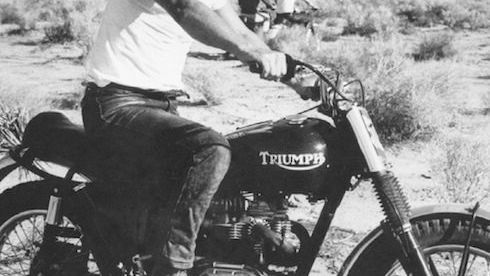

Words: Freddie Church
Speed is addictive. The idea of throwing yourself around a dirt track at the highest speed possible can’t help is one of the most appealing activities a gentleman can take part in. The sheer exhilaration and hit of adrenaline is something seriously worth chasing. And one of the best ways to do this is by riding a motorcycle: one piece of kit that creates the ultimate synergy between man and machine. Nowhere do you feel more alive and in control than when your sat behind the handlebars of a motorcycle, twisting that throttle for all it’s worth. Some prefer road racers but for us, dirt bikes rival everything else, often because they are lighter machines and can consequently feel like they are going that extra bit faster.
Kawasaki 100 Centurion
(Photo: Bonhams)
This particular bike is a one of a kind. It once belonged to the king of cool, and confirmed bike enthusiast Steve McQueen and was first built in 1970, due to a huge increase in the popularity of off-road racing. Originally off-road racing was done on converted large-capacity road bikes, however people often found them to heavy and difficult to control in the dirt. This was one of the first lightweight bikes specifically designed to be ridden off-road, and consequently dominated the off-road racing scene for many years.
This beauty was one of six given to McQueen for the filming of Le Mans by the Japanese manufacturer. He took five of them with him but left this one behind in his Santa Paula airport hanger. He asked his friend Kenny ‘Von Dutch’ Howard to change the original green paintwork on the bike to how it sits today, with the tank bright orange with gold stipe detailing and named it Ringadingdoo, which is probably a reference to the noise made by an un-silenced race-tuned two-stroke engine.
Triumph TT Special
(Photo: Bonhams)
Another favourite of Steve McQueen and his stunt man, Bud Ekins, in The Great Escape in 1963 and at this point, modified Triumphs were already becoming very successful in off-road races. The TT was a high performance factory race bike, stripped down and performance tuned to fill the niche markets of off-road racing. The Triumph factory racer came with higher compression pistons, hotter camshafts and a high output ignition system, to produce 54hp at 6,500 rpm
Closer ratio gears were installed in the four speed gearbox, chain drive sprocket ratios were altered, and larger diameter exhaust pipes were tucked under the frame, without mufflers. Aluminum, or more durable stainless steel fenders replaced the street items. Lights, fork lock and speedometer were all done away with and only a tachometer was fitted. The forks received special springs and internal valving. These stripped down bikes weighed 350 pounds, some 30 pounds lighter than the normal factory set up making it unbelievably fast. In an attempt to further separate this race model from their street running models, the Bonneville-derived 2 ½ gallon fuel tanks came with special paint options. For 1967, the colours were aubergine over either gold or white, pin-striped in gold by hand.
Rickman Triumph Metisse 498cc T100c
(Photo: Bonhams)
The Metisse was built by the Rickman brothers in 1959, and the gentlemen were already motocross stars in their own right, with an enviable pedigree and knowledge of what it would take to build an exceptional off-road bike. Within a decade, Rickman would go on to become one of the most well-regarded independent motorcycle frame makers in the world. The first Rickman frame, known as the Mk3 was introduced in 1961, which was then surpassed by this more compact Mk4 frame and was specifically designed to fit the increasingly powerful Triumph and BSA Victor engines.
JAWA 250 Type 579
(Photo: Bonhams)
In the 1950s, Czechoslovakia was at the forefront of development in motocross, a success that can be attributed to this bike. The development occurred when Czechoslovakia’s national arms factory diversified into the manufacture of motorcycles. The company’s founder, Frantisek Janacek, bought the motorcycle division of German company Wanderer and named it JAWA. Throughout the succeeding two decades, the company’s main claim to fame was an outstanding run of success in the ISDT and in international motocross. This bike came complete with with the compact engine, rear wheel suspension and many other innovations, and was exported to more than 120 countries worldwide, making it one of the most successful models of JAWA.
Greeves Hawkstone Scrambler
(Photo: Bonhams)
In 1956, Greeves signed Motocross rider Brian Stonebridge who was not only an exceptional rider, but also a tuning expert, enabling him to optimise the Villiers engines used on the bike. His incredible skills meant that he won on the demanding and hilly Hawkstone Park, against much larger capacity 500cc bikes. That success for the company led to the creation of this, the ‘Hawkstone’ scrambler, designed specifically to deal with the toughest terrain.
Husqvarna 250 MX
(Photo: Silodrome)
Bikes like this from the Swedish company, Husqvarna, dominated the dust and mud throughout the 60s and 70s, winning 14 motocross world championships, 24 enduro world championships and 11 Baja 1000 victories across the 125cc, 250cc and 500cc classes. These bikes are remarkably adept at almost any kind of off-road racing; its lightweight, punchy engine and reliable nature was a major contributing factor in the successes enjoyed by the company. These bikes were also incredibly popular due to their famous fans, Malcom Smith rode one in On Any Sunday and Steve McQueen raced and won on these bikes with their distinctive red tanks so frequently, that he became an unofficial company mascot and is still closely associated with the brand more than forty years later.
Penton Wassell 125 Sachs Trials
(Photo: Bonhams)
Founded in 1946, W.E Wassail Limited was establish in Birmingham as a manufacturer of motorcycle parts for firstly British, and then later Japanese bikes. There wasn’t an off-road bike in Britain that didn’t use Wassail parts. In 1972, the company announced trials and scrambles frame kits for both the BSA Bantam and finally this, its own 125cc machine, which was powered by the German made Sachs engine. This was an incredibly powerful and nimble machine.
BSA B50 MX
(Photo:Bonhams )
The B50 was derived from the earlier 250cc BSA C15/Starfire. It launched in 1971 and about 5,700 were produced across the range including the B50MX. It was a single-cylinder 499cc. The very last MXs produced, came out in 1973 and were therefore coming off the production line after BSA as a company had folded. They were instead badged as the Triumph TR5MX. This, gentlemen, is a throwback to the golden age of British motorcycle manufacture.
Maico 450
(Photo: Bonhams)
German bike makers Maicowerk AG was founded in 1926, but Maico is mainly remembered today as one of the leading motocross-bike makers of the 1970s. Renowned for their good handling and grunty power, Maicos gave an excellent account of themselves in international competition, in spite of their rather limited racing budget. With a reputation for razor-sharp turning, Maico 400 and later 450 models (actually 438cc) were the bike of choice for Open-class riders in America. They are still sought after today for vintage MX racing.
OSSA 250 MAR
(Photo: Bonhams)
Founded in 1924, Ossa started making projectors and after World War Two, the company transitioned to making motorcycles. They specialised in producing two-stroke engined motorcycles and were firm supporters of all forms of motorcycle racing. After having some success in the road racing world, but losing their star rider in 1970, the company redirected their efforts entirely into the sport of observed trials, aiming to emulate the successes of rivals Bultaco and Montesa within this form of racing. Having already hired English trials star Mick Andrews in 1967, who was only 23 but already an an exceptional rider, Andrews set about developing Ossa’s existing trail bike into a competitive trials bike, a process that culminated in the MAR – Mick Andrews Replica – that was responsible for him winning consecutive European Trials Championships in 1971 and 1972.
For more information, see Bonhams
Main and featured image: CycleWorld Magazine


